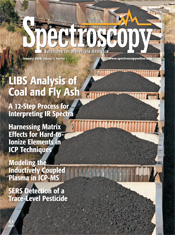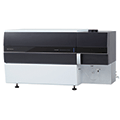In our January issue:
COLUMNS
IR Spectral Interpretation Workshop
A Process for Successful Infrared Spectral Interpretation
Brian C. Smith
A 12-step program to help you be more successful at interpreting IR spectra.
Read more >>
|
| |
 |
Lasers and Optics Interface
Improved Measurement Characteristics of Elemental Compositions Using
Laser-Induced Breakdown Spectroscopy
Z. Wang, Y. Deguchi, S. Katsumori, A. Ikutomo, J. Yan, J. Liu, K. Tainaka, K. Tanno, H. Watanabe, and R. Kurose
Rapid detection of coal and fly ash is significant for improving the efficiency of thermal power plants and reducing pollution. LIBS has great potential for on-line measurement in these applications.
Read more >> |
Spectroscopy Spotlight
ICP-MS for Environmental and Bioimaging Research
Uwe Karst of the University of Münster in Germany discusses his group’s work using ICP-MS for applications such as analyzing magnetic resonance imaging (MRI) contrast agents in river water, speciation analysis in a study of a disease related to renal failure, and examining the distribution of a labeling compound in mouse tumor cells and macrophages.
Read more >> |
| |
|
|
PEER-REVIEWED ARTICLE
Surface-Enhanced Raman Spectroscopy for Trace-Level Dimethoate Detection Based on a Silver Nanoparticle–Probe–Smooth Gold Film Substrate
Z. Wu, X. Wang, Y. Wang, and J. Wu
The performance of a new SERS substrate is tested for trace detection of a pesticide.
Read more >>
|
| |
|
|
SPECIAL FEATURES
How to Improve Analytical Figures of Merit of Hard-To-Ionize Elements in ICP-Based Techniques
Matrix effects in ICP-OES and ICP-MS often cause signal suppression, but can lead to signal enhancement as well. Guillermo Grindlay of the University of Alicante, in Spain, discusses his work to better understand under what conditions these matrix effects occur and what mechanisms are involved.
Read more >>
What Modeling Reveals About the Properties of an Inductively Coupled Plasma
Annemie Bogaerts and Maryam Aghaei of the University of Antwerp, Belgium, are carrying out computational modeling to examine how various properties of the ICP, such as gas flow path lines and ionization effects, are affected by various factors—such as gas flow rates, applied power, and even the very presence of a mass spectrometry sampler. Using their developed model, one can predict optimum conditions for specific analyses.
Read more >>
|
| |
|
 |
Download the
issue: |
 |
 |
 |
 |
| |
| LIVE WEBCASTS |
Editors' Series: New Applications of ICP-MS in Bioanalysis
Wednesday, January 27, 2016 at 8 am PST/ 10 am CST/ 11 am EST
Register Here >> |
Think Blank: Clean Chemistry Tools for Atomic Spectroscopy
Thursday, January 28, 2016 at 10 am EST/ 9 am CST/ 7 am PST
Register Here >> |
| |
| ON DEMAND WEBCASTS |
ICP-OES or Flame AAS – Which Spectroscopic Method is Best for You?
Register Here >> |
Reduce the Cost of Quality Control Using Near-IR Spectroscopy
Register Here >> |
Dealing with High-Matrix Environmental Samples: Part 2: Improve Your ICP Instrumentation Uptime—Essential Hints and Tips
Register Here >> |
|
If you would like to submit an article to Spectroscopy, contact Laura Bush, Editorial Director - lbush@advanstar.com
Spectroscopy is free to qualified subscribers. To subscribe, click here.
Click here to contact the Spectroscopy sales team. |




